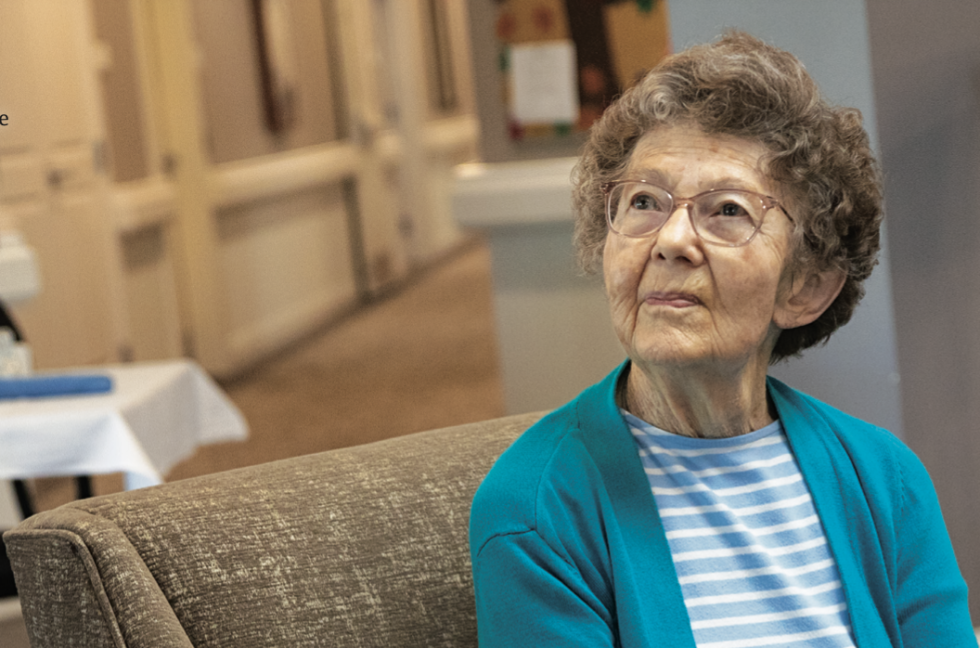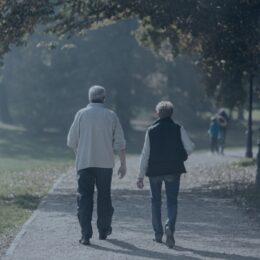
By Jan Simpson
It was Christmas. My mother was now a grandmother to 18 and a great-grandmother to 10. It was my year to host our annual Christmas party. While my sister Ginny offered to bring the aide to help with Mom, I told her no. Ron and I moved a recliner into our sunroom near the Christmas tree so if my mother needed a nap or a quiet place to relax, we could shut the doors, and she could enjoy the twinkling lights or close her eyes and sleep.
The party energized my mother. She sat and watched the loud antics of her grandchildren, hooting over the gifts in the grab; she ate a full meal including dessert; and she posed happily for photographs with her children and grandchildren.
While Ron tended the food, I tended to her needs, discretely taking her to the bathroom when the others were occupied. She was upbeat and engaged.
I learned a lot about living with chronic illness by watching Ron’s parents age. The most important lesson was not a medical one, but an attitudinal one.
Ron’s father had lived with multiple sclerosis (MS) for more than 40 years. I had been part of his family for 16 of those years, during which time his medical crises became increasingly more serious. Never once, however, did I hear any of his family refer to him as handicapped. He used a wheelchair. He struggled with a wide array of complications from MS. Yet, he never lived like a disabled man, but rather an able man living with a devastating disease.
Each time we were together we talked about the stock market and business. We joked about politicians and liberal women, and we enjoyed many cups of coffee, chatting about his family. His illness was the elephant in the room, squeezed into the far corner, and acknowledged only when it thrashed about.
We treated my mother in a similar way, assuming that she was able to read, to walk, to feed herself, to make decisions, until she proved herself unable to do so. And at that point, we adjusted her care, took stock of her strengths, and moved on, assuming that she would tell us, either by words or actions, when she lost more ability.
So far, like Ron’s father, she was defying the odds. Surely, there were more moments when she appeared disconnected from us, withdrawing into her own world, sometimes in a seizure-like state, unable to be roused or distracted. But on some days, days like that Christmas, she was focused, observant, and engaged. I took each moment as it was, appreciating the times of higher lucidity.
I tucked an afghan around her after everyone had left our house and encouraged her to nap in the recliner. Ron and I chatted happily in the kitchen, cleaning up the dishes, when suddenly there was a loud crash. Ron’s eyes met mine in a startled gaze. “Oh my!” I gasped, heading for the sunroom. “I never should have left her alone!” I swung open the door with Ron on my heels. The Christmas tree lay on the floor, its branches snapped, glass ornaments shattered around the room. And there, just inches away from the broken branches, was my mother, snoring gently in the recliner. Ron and I shrieked with laughter. Hearing our voices, my mother awoke, unappreciative of the interruption of her nap. We moved her chair to the den where she could resume sleeping.
“Next year, remind me to secure the tree to the wall!” Ron said between chuckles, and we spent the rest of the night cleaning up the mess.
***
Three weeks into the new year, my mother tripped and fell. It was early Sunday morning, about 2:30. According to the weekend help, she had been restless and got out of bed unattended, falling on her way to the bathroom. The aide, however, neglected to tell Ginny and Jon about the fall, and it was noted only when Helen observed bruising on her face and shoulders Sunday evening. The aide’s negligence was reported to the agency, and she was replaced immediately.
My mother took Coumadin, a blood thinner, to help prevent strokes. That medicine made her particularly vulnerable to internal bleeding from falls, and, on Monday, Helen became increasingly concerned, noting that my mother’s right eye was drooping and the bruises on her shoulder and body were intensifying. She took my mother to the emergency room at the Lahey Clinic, where she was admitted with a diagnosis of pneumonia. That afternoon, Walter called to see how Mom was doing and volunteered to stop by and see her for me— Katie had a fever of 102 degrees, so I couldn’t leave her alone.
He called later that evening. “I just left the hospital,” he said, sounding exasperated. I glanced at the kitchen clock: it was after nine o’clock. “When I arrived at five thirty,” he said, “she was still in the emergency room.”
“From early this morning?”
“Yeah, apparently no one signed the consent form.” I felt a quick wave of guilt thinking of my poor mother waiting for hours in the emergency room because no one had authorized her admission.
“Oh, Walter,” I said apologetically, “I didn’t know that. No one called me, or I would have run over.”
“Well, I signed the forms,” he said. “And I waited with her until she got into her room. I had to cancel my plans for tonight.”
I sighed. After our father died, Walter had made it clear that he thought our mother belonged in a nursing home, but over time, he had become appreciative of our arrangement for her and did what he could to be helpful. Before her apartment attached to Ginny’s home was finished, he drove our mother between houses to save Ginny and me the trip during the week. When she was hospitalized, he always visited, bringing an ice cream frappe along with jovial stories for her and the nurses. And although he didn’t spend anywhere close to the number of hours Ginny and I did with our mother, he was, in fact, still caring and considerate of her needs.
The next day, I brought Katie with me for a quick visit to check on my mother. Her attending physician recommended that we take her off Coumadin because the risk of hemorrhage from falling outweighed the risk of a stroke. I made a note to check with Dr. Harmon, her primary care physician.
A social worker also stopped by to meet me, recommending that we consider moving my mother to a rehabilitation center with a memory unit. To her surprise, I said that I would prefer to bring her home, knowing how poorly she fared in institutions. The social worker understood but explained that keeping my mother at the Lahey Clinic for three consecutive nights allowed us to move her to a facility within 30 days of her release and still be eligible for Medicare coverage for up to 100 days.
I had no intention of moving her to an institutional setting without inspecting it first, but I appreciated having that option.
This social worker connected me with the Visiting Nurse Association (VNA) of Middlesex-East, who sent out a nurse, social worker, physical therapist, and an occupational therapist.
The therapists gave us a list of daily exercises to build strength and hand flexibility, such as rolling play dough, playing balloon volleyball while sitting, and using an elastic stretch band.
This VNA also had a program for Alzheimer’s families, free of charge, that included once-a-month visits by a member of the care team. Where have you been all these years? I had not known that the level of services provided varies among different VNA branches. This branch, I would later learn, was one of the best in the area. My mother recovered from her hospitalization at home.
It was her 16th year in her Alzheimer’s journey. She walked slowly, shuffling mostly, needing assistance. Her urinary incontinence was increasing. We often needed to feed her, and her diet had shifted to soft foods like oatmeal, Ensure, and soups.
Although she smiled and acknowledged us using facial expressions and nods, we no longer had conversations; she rarely spoke more than a few words. Her balance was unsteady and her falling would likely continue. We purchased a bed alarm and ordered a hospital bed, with side bars, provided free of charge from Medicare with a written prescription from Dr. Harmon. The VNA became our ready advisers for resources and medical needs.
* * *
It was Valentine’s Day, and the telephone rang as I was filling bags of candy for Katie’s annual party. The girls would arrive shortly after school.
“Is Jan Simpson there?” Dr. Harmon asked, his Scottish brogue disclosing his identity.
“Yes, Dr. Harmon,” I said, placing the candy bag on the counter. “It’s Jan. Is everything okay?” My mother had just been to the doctor earlier that week for a checkup. It was unusual for Dr. Harmon to call me at home.
“Your mother’s Protime was a bit off,” he began, noting that the lab test that measured the clotting time of my mother’s blood indicated that we needed to adjust the dosing of her medication. I grabbed a pen and wrote down the change, but my antennae were up—something was wrong.
“I want to run more tests on your mother,” he said slowly. “I’d like to take some stool samples.”
“Stool samples?” I asked. Ugh.
“I’ll have Sandy send out the test kit. The instructions are inside the package. You’ll need to take three samples and bring them to the laboratory.”
“What do you think is wrong?” I asked, ignoring my initial disgust.
“She may be bleeding rectally,” he said, and my eyebrows shot up. Huh? Rectal bleeding was not among the list of things Joan, her nurse at the adult-day care center, had forewarned me about. “She could have colon cancer.”
I rubbed my forehead in disbelief. We continued to talk about the testing required. As the initial shock of the word “cancer” wore off, I realized that I needed to learn what his game plan was for my mother. I pressed for more details.
“Suppose the test is positive, that she is bleeding, then what? Wouldn’t you need to scope her to see what is going on? And then, if you found something, wouldn’t she need surgery?” He replied affirmatively.
“Dr. Harmon,” I sighed exasperated, “Are you honestly going to recommend that we cut her open? She is 82-years-old with heart disease and Alzheimer’s disease. She would not survive surgery.” He agreed.
“So, why go down this path? Why put her through these tests?” My mother was not going to be poked and probed, not at this stage—she was too frail. After more discussion, Dr. Harmon and I agreed that we should proceed with the stool samples, to at least confirm that there was, in fact, a problem, but we would be unlikely to take things any further.
I called my brother-in-law Jon to tell him about my mother’s medication change. I did not tell him about the cancer. Next week, after the test kit arrived, I would deal with the stool samples.
“Stool samples,” I mumbled, shaking my head and picking up another candy bag to fill. “What’s next?”
The following morning the telephone rang. It was eight o’clock, and Ron’s mother was on the line. She sounded distraught.
“I wanted Ron to know that the EMTs are here, and they’re working on Dad,” she said, starting the conversation midstream. “He’s not responding.”
Ron was running an errand with Eric, so I called his cell phone. Ron returned his mother’s call and then called me back, confirming what I had suspected. Ron’s father had passed away.
That afternoon Ron flew down to New York to be with his mother. Eric, Katie, and I drove to her house the following morning.
Ron’s father was a Navy veteran of World War II. His military funeral was held at Calverton National Cemetery on Long Island. At the close of the ceremony, two soldiers removed the flag from his casket, folding it into a tight triangular package. A soldier stood before my mother-in-law.
“On behalf of the President of the United States, the Department of Defense, and a grateful Nation, we offer you this flag for the faithful and honorable service of your loved one.”
Fifty-two million people died during World War II, including 500,000 Americans who left behind grieving mothers, struggling widows, and lonely children. Sixteen million Americans participated in the war, hundreds of thousands returned home physically disabled, and all returned psychologically changed. Both of my grandmothers had sent three of their four children into battle; Ron’s father had served in the Office of Strategic Services in Rome.
As I watched my mother-in-law place the flag gently on her lap, slowly smoothing the surface with her gloved hand, I realized how much she and he had endured in their lifetime without complaint. In recent years, I had begun to think that I had sacrificed my career to help my parents, but this funeral reminded me that I could only begin to comprehend a real sacrifice. Ron’s father and his generation knew the true meaning of sacrifice, and they had been good teachers.
As we drove away from the cemetery, I felt grateful for having spent the last few years learning from them.
© Jan Simpson, Circle of Life Partners. Reprinted with permission.
Jan Simpson is the author of “Don't Give Up on Me! Supporting Aging Parents Successfully”
Photo by Ashley Wiehe


